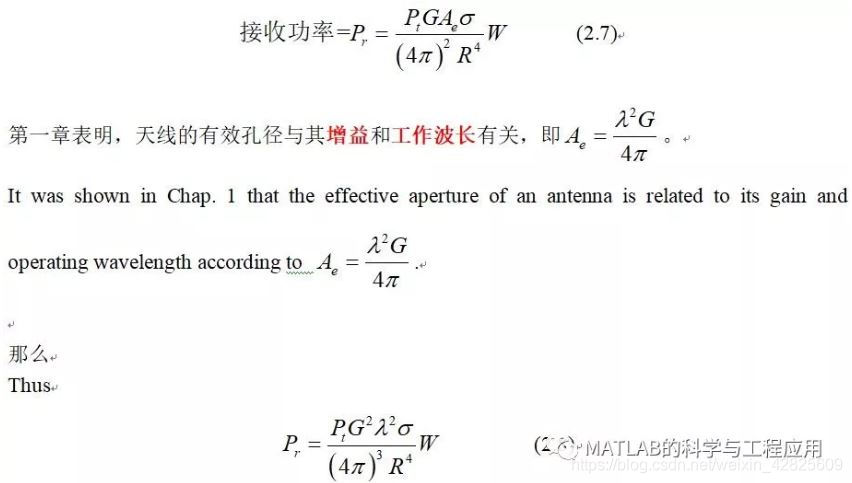如果雷达天线的有效孔径尺寸为Ae平方米,则接收天线收集的总后向散射功率为
If the effective aperture size of the radarantenna is Ae square meters, the total backscattered power collectedby the receiving antenna will be

式(2.8)描述了理想雷达系统在自由空间工作时,如果不使用信号处理技术来提高灵敏度时接收到的回波功率。
Equation (2.8) describes the power thatwould be received if an ideal radar operated in free space and used no signalprocessing techniques to improve sensitivity.
雷达方程中通常会添加各种额外的损失和增益因素,以考虑各种可能的影响。
Various additional loss and gain factors arecustomarily added to the formula to account for a variety of additionalconsiderations.
例如,在诸如双工器、功分器、波导和天线罩(天线上的保护层)等各种组件中产生的损耗,以及在自由空间传播中未发现的传播效应,都可以集中到降低雷达接收功率的系统损耗因子Ls上。
For example, losses incurred in variouscomponents such as the duplexers, power dividers, waveguide, and radome (aprotective covering over the antenna), and propagation effects not found infree space propagation, can be lumped into a system loss factor Lsthat reduces the received power.
系统损耗通常在3到10分贝范围内,但不同系统的变化很大。
System losses are typically in the range of3 to 10 dB but can vary widely.
大气衰减La®是最重要的损耗因子之一,特别是在X波段及更高的电磁波频率条件下。
One of the most important loss factors,particularly at X band and higher frequencies, is atmospheric attenuation La®.
与系统损耗不同,大气衰减是距离的函数。
Unlike system losses, atmospheric lossesare a function of range.
如果图1.3中以分贝/千米度量的单向损失用α表示,则距离R米(不是千米)处目标的损失以分贝表示为
If the oneway loss in decibels perkilometer of Fig. 1.3 is denoted by α, the loss in decibels for a target atrange R meters (not kilometers) is

在10GHz及适当的距离范围内,大气损失可能是无关紧要的;而在60GHz及几公里范围内,大气损失可能达到几十分贝。
Atmosphericloss can be inconsequential at 10 GHz and moderate ranges, or tens of decibelsat 60 GHz and a range of a few kilometers.
这就是为什么60GHz不是常用雷达频率的原因。
This isthe reason why 60 GHz is not a popular radar frequency.
这个例子还表明,大气损失和系统损失一样,也是一个与雷达频率强相关的函数。
Thisexample also shows that, like system losses, atmospheric loss is a strongfunction of radar frequency.
将大气和系统损失代入式(2.8)中,最终得到
Incorporatingatmospheric and system losses in Eq. (2.8) finally gives

式(2.11)是雷达距离方程的一种简单形式。
Equation (2.11) is one simple form of theradar range equation.
该方程将接收到的回波功率与基本雷达系统、目标参数(如发射功率、工作频率和天线增益)、雷达横截面积和距离联系起来。
It relates received echo power tofundamental radar system and target parameters such as transmitted power,operating frequency, and antenna gain; radar cross section; and range.
由于雷达信号的功率与电场振幅的平方成正比,距离方程也可作为目标幅度和信号杂波分量的模型。
Because the power of the radar signal isproportional to the square of the electric field amplitude, the range equationalso serves as a model of the amplitude of the target and clutter components ofthe signal.
请注意,式(2.11)中的所有变量都是线性单位,而不是分贝,而一些参数通常以分贝表示;常见的参数包括大气损失、天线增益和RCS。
Note that all variables in Eq. (2.11) arein linear units, not decibels, even though several of the parameters are oftenspecified in decibels; frequent examples include the atmospheric losses,antenna gain, and RCS.
同时请注意Pr是瞬时接收功率,而不是平均功率。
Also note that Pr isinstantaneous, not average, received power.
最后,对于距离为R的散射体,在雷达发射后的2R/c秒接收到后向散射的电磁波。
Finally, realize that for a scatterer atrange R, the backscattered EM wave will be received with a time delay of 2R/cseconds after transmission.
——本文译自Mark A. Richards所著的《Fundamentals of Radar Signal Processing(Second edition)》
更多精彩文章请关注微信号:







 本文探讨了雷达信号处理的基本原理,详细解析了雷达方程,并讨论了影响雷达接收功率的因素,如系统损耗、大气衰减及雷达频率的作用。通过具体实例说明了这些因素如何影响雷达性能。
本文探讨了雷达信号处理的基本原理,详细解析了雷达方程,并讨论了影响雷达接收功率的因素,如系统损耗、大气衰减及雷达频率的作用。通过具体实例说明了这些因素如何影响雷达性能。
















 1123
1123

 被折叠的 条评论
为什么被折叠?
被折叠的 条评论
为什么被折叠?








